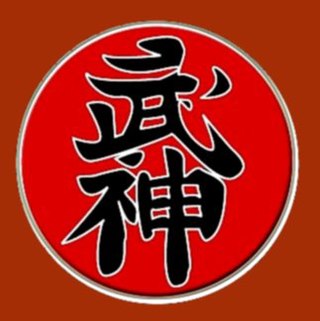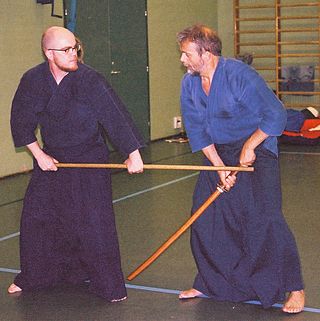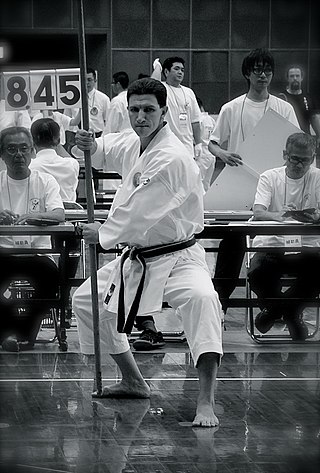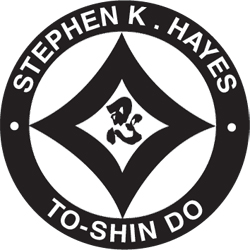
The Bujinkan is an international martial arts organization based in Japan and headed by Masaaki Hatsumi. The combat system taught by this organization comprises nine separate ryūha, or schools, which are collectively referred to as Bujinkan Budō Taijutsu. The Bujinkan is most commonly associated with ninjutsu. However, Masaaki Hatsumi uses the term Budo as he says the ryūha are descended from historical samurai schools that teach samurai martial tactics and ninjutsu schools that teach ninja tactics.
Masaaki Hatsumi, formerly Yoshiaki Hatsumi, is the founder of the Bujinkan Organization and is the former Togakure-ryū soke (grandmaster). He no longer teaches, but currently resides in Noda, Chiba, Japan.
Kukishin-ryū (九鬼神流), originally "Nine Gods Divine School" is a Japanese martial art allegedly founded in the 14th century CE by Kuki Yakushimaru Ryūshin. It is a sōgō bujutsu, meaning that it teaches several different weapons/arts such as taijutsu, bōjutsu, naginatajutsu, kenpō, hanbōjutsu, sōjutsu and heiho. Kukishin-ryū and its founder are listed in the Bugei Ryūha Daijiten or "The Encyclopedia of Martial Art Schools", a record of modern (gendai) and old lineage (koryū) Japanese martial schools.

Bōjutsu is the martial art of stick fighting using a bō, which is the Japanese word for staff. Staffs have been in use for thousands of years in Asian martial arts like Silambam. Some techniques involve slashing, swinging, and stabbing with the staff. Others involve using the staff as a vaulting pole or as a prop for hand-to-hand strikes.

A bō, pong (Korean), pang (Cantonese), bang (Mandarin), or kun (Okinawan) is a staff weapon used in Okinawa. Bō are typically around 1.8 m (71 in) long and used in Okinawan martial arts, while being adopted into Japanese arts such particular bōjutsu. Other staff-related weapons are the jō, which is 1.2 m (47 in) long, and the hanbō, which is 90 cm (35 in) long.
A jō is an approximately 1.27-metre (4.2 ft) wooden staff, used in some Japanese martial arts. The martial art of wielding the jō is called jōjutsu or jōdō. Also, aiki-jō is a set of techniques in aikido which uses the jō to illustrate aikido's principles with a weapon. The jō staff is shorter than the bō. Today, the jō is still used by some Japanese police forces.

The tanbō is a short staff weapon used in Okinawa and feudal Japan. Today the tanbō is used by various martial arts schools.

A bisentō was a pole weapon used in feudal Japan. The bisentō has various descriptions, "a double-edged long sword with a thick truncated blade", "a spear-like weapon with a blade at the end that resembles a scimitar", "a polearm resembling a glaive, with a long, heavy haft and a heavy, curved blade". The bisentō is said to have been used by ninja and peasants.

Shintō Musō-ryū, or Shindō Musō-ryū (神道夢想流), most commonly known by its practice of jōdō, is a traditional school (koryū) of the Japanese martial art of jōjutsu, or the art of wielding the short staff (jō). The technical purpose of the art is to learn how to defeat a swordsman in combat using the jō, with an emphasis on proper combative distance, timing and concentration. The system includes teachings of other weapon systems which are contained in Shintō Musō-ryū as auxiliary arts. The school is sometimes abbreviated as SMR.
Toshitsugu Takamatsu was a Japanese martial artist and teacher of Bujinkan founder Masaaki Hatsumi. He has been called "The Last Shinobi" by Bujinkan instructor Wolfgang Ettig.
Hinoshita Torite Kaisan Takenouchi-ryū is one of the oldest jujutsu koryū in Japan. It was founded in 1532, the first year of Tenbun, on the twenty-fourth of the sixth lunar month by Takenouchi Chūnagon Daijō Nakatsukasadaiyū Hisamori, the lord of Ichinose Castle in Sakushū. Although it is famous for its jūjutsu, Takenouchi Ryū is actually a complete martial art, including armed grappling, staff (bōjutsu), sword (kenjutsu), sword drawing (iaijutsu), glaive (naginatajutsu), iron fan (tessenjutsu), restraining rope (hojōjutsu), and resuscitation techniques (sakkatsuhō). Its jūjutsu techniques have been influential in the founding of many other schools in Japan. Takenouchi Ryū is still actively transmitted today by members of the Takenouchi family, as well as by other groups both within and outside Japan.

Okinawan Kobudō (沖縄古武道), literally "old martial way of Okinawa", is the weapon systems of Okinawan martial arts.

Musō Gonnosuke Katsuyoshi (夢想權之助勝吉) was a samurai of the early 17th century and the traditional founder of the Koryu school of jojutsu known as Shintō Musō-ryū (神道夢想流/神道無想流). He is perhaps most famous for his duels with the legendary swordsman Miyamoto Musashi.

Zen Nihon Kendō Renmei Jōdō, or Seitei Jōdō in short, is a modern form of jōdō created by Japanese martial artist Shimizu Takaji and presented to the All Japan Kendo Federation in 1968.

Jōdō (杖道), meaning "the way of the jō", or Jōjutsu (杖術) is a Japanese martial art using a short staff called jō. The art is similar to bōjutsu, and is strongly focused upon defense against the Japanese sword. The jō is a short staff, usually about 3 to 5 feet long.

Hōten-ryū (法典流) is a Japanese martial art founded in 1600 CE. It is a school founded on the use of the sword; however it has several different kobuki in its curriculum. It is also notable for its hidden weapons or items that appear to hide among everyday things.
Toda Shinryuken Masamitsu (戸田真竜軒正光) (1824–1909) is mentioned in the Bugei Ryuha Daijiten as being the head master of several styles of Japanese martial arts, including:
Modern schools of ninjutsu are schools which offer instruction in martial arts. To a larger or smaller degree, the curriculum is derived from the practice of ninjutsu, the arts of the Shinobi; covert agents of feudal Japan.
Togakure-ryū (戸隠流) is a historical tradition of ninjutsu known as the "School of the Hidden Door", allegedly founded during the Oho period (1161–1162) by Daisuke Nishina (仁科大助), who learned his original fighting techniques from a Chinese monk named Kain Dōshi. However, the history and early lineage of Togakure-ryū may be impossible to verify due to the antiquity of the time period and its claimed historicity has been disputed by Watatani Kiyoshi, writer for the Bugei Ryūha Daijiten. After Togakure, the title of Sōke was recorded by Toda Shinryuken Masamitsu to have been passed down through other practitioners that kept the style secret from the outside world.

To-Shin Do is a martial art founded by Black Belt Hall of Fame instructor Stephen K. Hayes in 1997. It is a modernized version of ninjutsu, and differs from the traditional form taught by Masaaki Hatsumi’s Bujinkan organization. Instruction focuses on threats found in contemporary western society. In addition to hand-to-hand combat skills, students are exposed to: methods for survival in hostile environments, security protection for dignitaries, how to instruct classes and run a school, classical Japanese weapons, meditation mind science, and health restoration yoga. The headquarters school (hombu) is located in Dayton, Ohio, USA.











